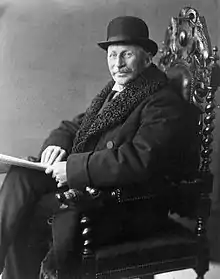1904 Reading by-election
The Reading by-election was a Parliamentary by-election held on 6 August 1904.[1] The constituency returned one Member of Parliament (MP) to the House of Commons of the United Kingdom, elected by the first past the post voting system.
| ||||||||||||||||
| ||||||||||||||||
| ||||||||||||||||
Vacancy
George Palmer had been Liberal MP for the seat of Reading since the 1898 Reading by-election. He resigned from Parliament in 1904, due to advancing deafness.[2]
Electoral history
Since the Reading constituency was created in 1885 it had been closely contested between Liberal and Conservative; The Conservatives winning in 1885, 1886 and 1895 and the Liberals in 1892, 1898 and 1900. The Liberal victor on each occasion was Palmer, who was a very well known biscuit manufacturer in the town.[3] At the last election he had won narrowly;
| Party | Candidate | Votes | % | ±% | |
|---|---|---|---|---|---|
| Liberal | George William Palmer | 4,592 | 51.3 | -1.1 | |
| Conservative | Charles Edward Keyser | 4,353 | 48.7 | +4.2 | |
| Majority | 239 | 2.6 | -5.3 | ||
| Turnout | 8,945 | 88.1 | -3.6 | ||
| Liberal hold | Swing | -2.6 | |||
Candidates

- The local Liberal Association selected 44 year-old Rufus Isaacs as their candidate to hold the seat. Isaacs was a London barrister who had been made a QC in 1898. He was standing as a candidate for the first time.[5] In such a marginal seat, the Liberals were taking a risk by choosing an outsider to replace a well-known local man.

- The local Conservative Association selected 57 year-old stockbroker Charles Keyser as their candidate. He was contesting Reading for the third time, having lost to Palmer in 1898 and 1900.[6]
- There was some expectation of a socialist candidate making it a three-way contest, as had been the case in the 1898 by-election.
Campaign
Polling day was fixed for the 6 August 1904.
Result
The Liberals held the seat with an almost identical result to the previous election;
| Party | Candidate | Votes | % | ±% | |
|---|---|---|---|---|---|
| Liberal | Rufus Daniel Isaacs | 4,770 | 51.2 | -0.1 | |
| Conservative | Charles Edward Keyser | 4,540 | 48.8 | +0.1 | |
| Majority | 230 | 2.4 | -0.2 | ||
| Turnout | 9,310 | 83.5 | -4.6 | ||
| Liberal hold | Swing | -0.1 | |||
Aftermath
Keyser did not stand for parliament again. At the following General Election, Isaacs was re-elected;
| Party | Candidate | Votes | % | ±% | |
|---|---|---|---|---|---|
| Liberal | Rufus Daniel Isaacs | 5,407 | 53.4 | +2.2 | |
| Conservative | George Horace Johnstone | 4,710 | 46.6 | -2.2 | |
| Majority | 697 | 6.8 | +4.4 | ||
| Turnout | 10,117 | 91.6 | +8.1 | ||
| Liberal hold | Swing | +2.2 | |||
References
- Craig, F.W.S. (1987). Chronology of British Parliamentary By-elections 1833–1987. Chichester: Parliamentary Research Services. p. 98.
- "Election intelligence". The Times. No. 36781. London. 30 May 1902. p. 10.
- ‘PALMER, Rt Hon. George William’, Who Was Who, A & C Black, an imprint of Bloomsbury Publishing plc, 1920–2016; online edn, Oxford University Press, 2014 ; online edn, April 2014 accessed 5 January 2017
- British Parliamentary Election Results 1885-1918, FWS Craig
- ‘READING’, Who Was Who, A & C Black, an imprint of Bloomsbury Publishing plc, 1920–2016; online edn, Oxford University Press, 2014 ; online edn, April 2014 accessed 5 January 2017
- ‘KEYSER, Charles Edward’, Who Was Who, A & C Black, an imprint of Bloomsbury Publishing plc, 1920–2016; online edn, Oxford University Press, 2014 ; online edn, April 2014 accessed 5 January 2017
- British Parliamentary Election Results 1885-1918, FWS Craig
- British Parliamentary Election Results 1885-1918, FWS Craig

